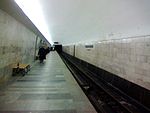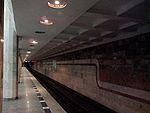Kharkiv State School of Art
AC with 0 elementsArt schools in UkraineBuildings and structures in KharkivUniversities and colleges in Kharkiv
The Kharkiv State School of Art (Ukrainian: Харківське державне художнє училище, KhDKhU) is an educational institution in Kharkiv, Ukraine. It accepts a new class of students each year for instruction in the subjects of visual arts education, sculpture, decorative arts, graphic design, and landscape architecture.
Excerpt from the Wikipedia article Kharkiv State School of Art (License: CC BY-SA 3.0, Authors).Kharkiv State School of Art
Nizhynskyi Entrance, Kharkiv Іванівка
Geographical coordinates (GPS) Address External links Nearby Places Show on map
Geographical coordinates (GPS)
| Latitude | Longitude |
|---|---|
| N 50.007778 ° | E 36.201944 ° |
Address
Харківське художнє училище
Nizhynskyi Entrance 1
61017 Kharkiv, Іванівка
Kharkiv Oblast, Ukraine
Open on Google Maps








